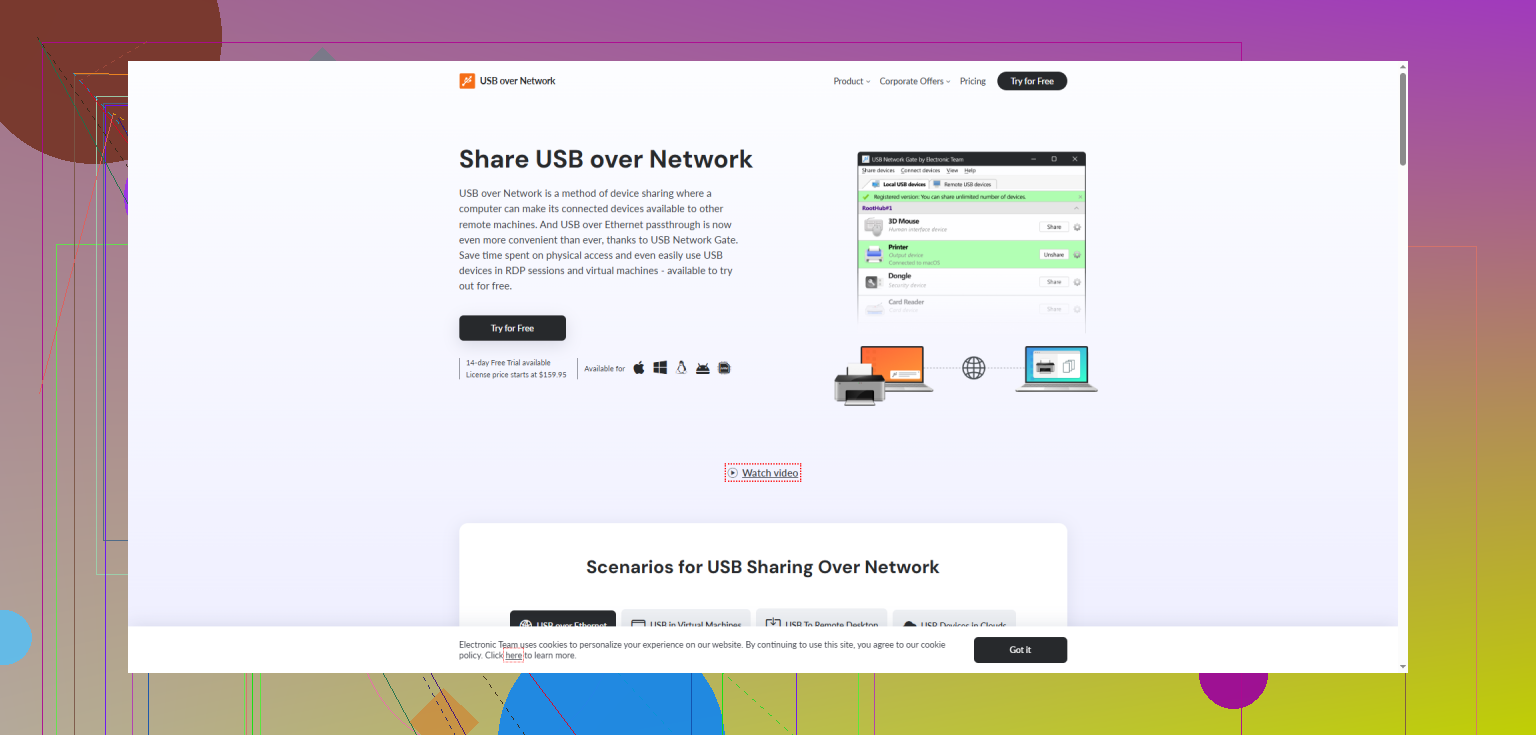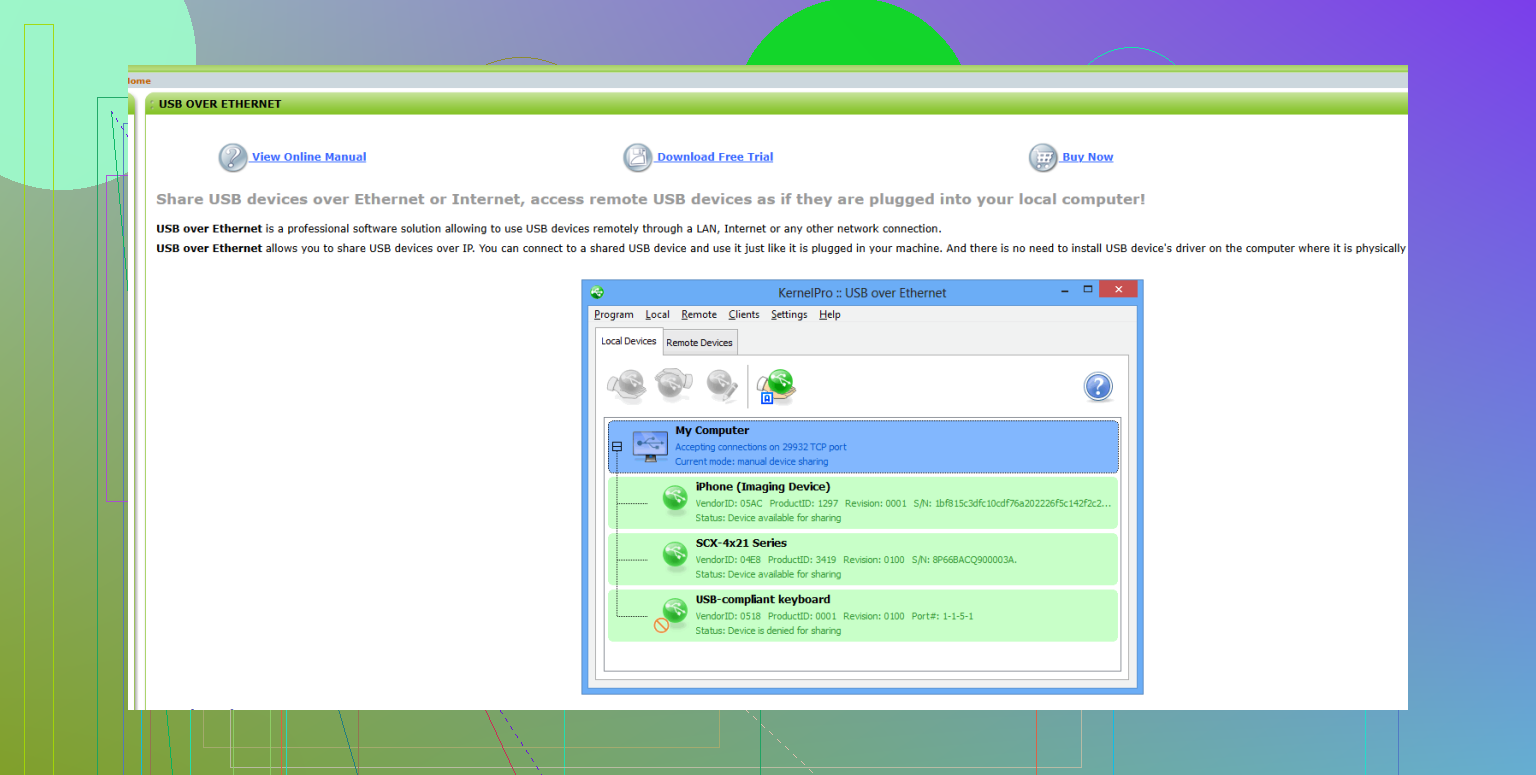I’m trying to connect a USB device over Ethernet, but it’s not showing up or working as expected. I’ve checked the cables and settings, but nothing seems to help. I really need to use my USB device remotely and would appreciate any suggestions or troubleshooting steps that could solve this problem.
Why I’d Pass on KernelPro USB Over Ethernet
So I got my hands on KernelPro USB over ethernet a while ago, thinking I’d finally found the perfect solution for my home lab. Nope. Turns out, it hasn’t seen a serious update in, what, half a decade? That’s like still rocking a flip phone when everyone else is on 5G. Plus, you can only throw one device onto the network at a time, which feels pretty stingy if you’re juggling a bunch of gadgets.
What Ended Up Working Way Better
After running into KernelPro’s walls, I kept poking around and landed on https://www.usb-over-ethernet.org/. Big difference. They let you hook up 10 devices out the gate, so it’s immediately more useful if you’ve got, say, a 3D printer, webcam, scanner, and whatever else kicking around. Price-wise, it’s way more upfront and fair—no guesswork about surprise fees—and it actually gets regular updates (crazy, right?).
Long Story Short
One device sharing just isn’t it in 2025—unless you live in a cave with one USB stick to your name. Swapping to this alternative has been a breath of fresh air and every bit worth the switch. If you’re still stuck on old software, you might want to check it out: https://www.usb-over-ethernet.org/.
Honestly, half the time USB-over-Ethernet stuff goes sideways, it’s not even the software or the hardware—it’s the weird combo of ‘em, or some random Windows/driver nonsense that should’ve died out with dial-up. Not gonna lie, even with perfect cables and “proper” settings, a lot of these so-called USB over Network solutions just act finicky for no reason, so you’re not alone. Saw @mikeappsreviewer talkin’ about KernelPro being outdated—hard agree there, but I’ll push back, cause even so-called “modern” apps sometimes flake out big time, especially with anything that isn’t just a plain ol’ USB thumb drive.
My issue was with the actual USB device itself—lots of USB sound interfaces, VR dongles, and security keys just hate being virtualized or shared. Some don’t pass through their driver-IDs or get “ejected” the second the network hiccups. Plus, you gotta check USB version compat—like if your device wants USB 3.0 bandwidth and your adapter is USB 2.0, you’re setting yourself up for pain. Windows Firewall and random “energy saver” settings cutting power to USB hubs have bit me more than once.
If you’re fed up with flakiness, might be worth checking out USB Network Gate. I was skeptical—thought it was just another cash-grab—until it worked where the free stuff bombed out. Cross-platform too, so if you’re weird like me and ping-pong between Mac and Windows and Linux, it won’t throw a fit.
Also, trust but verify—double check if the driver for your USB device is on both sides (host & client). Sometimes that’s all it needs. If none of that helps, maybe you need to rethink if the device has to be used remotely. Sometimes, remote desktop for simple file transfers gets the job done way less painfully.
If you want an actual how-to or want to see the different methods out there (including some tricks I haven’t mentioned), the breakdown here is pretty solid: USB over Ethernet solutions that actually work . Some of it is just nerd fodder, some of it actually gets your setup out of USB jail.
TL;DR—hardware limitations, driver stupidity, or just USB being persnickety. If you’re banging your head against KernelPro or the freebie apps, try USB Network Gate, but don’t expect miracles if your device itself is the diva in this drama.
A lot of the headaches with USB over Ethernet connections come down to the basic reality that USB just wasn’t designed to play nice over a network. Sure, the theory’s sweet—plug your printer/scanner/dongle in across the house and it just works. But the universe laughs at our hubris, and usually, it just… doesn’t.
From the sound of it, you’ve already double-checked the physicals (cables, ports, etc), so skipping the basics. One thing folks constantly overlook: the network environment. You got any aggressive firewalls, VLAN tricks, or smart switches ‘optimizing’ traffic? These can brick USB device discovery, and nothing in the fancy software UI will tell you the packet is being dropkicked into oblivion. It’s not just Windows firewall—think any network-level packet filtering or even “security” apps on your computers.
Another killer is device authentication. Some USB gadgets—especially those with bespoke drivers or security keys—require a handshake that’s hella sensitive to timing or expects a direct PCI bus/USB root hub it can sniff out. You can feed it all the virtualized hardware in the world and, nope, still doesn’t see it. @hoshikuzu brings up a good point about bandwidth and USB versioning. If you’re passing a USB 3.0 external SSD over Ethernet but your USB over LAN adapter or the network’s overall throughput bottle-necks to 2.0 speeds, expect intermittent disconnects or devices that just flat refuse to mount.
If you’re out here swapping software in and out and it’s still not lighting up, here’s a random thing—try a powered USB hub on the device side. Some devices, especially high-draw stuff, just don’t negotiate power delivery correctly when far from home base. Also, total curveball: some ‘energy saver’ and ‘USB selective suspend’ settings on the host can literally power down your remote USB. Windows excels at these mysteries.
About the solutions, @mikeappsreviewer and @hoshikuzu nearly cover most options but here’s a curve—there’s a subtle difference between true USB passthrough (like the stuff managed from the OS level or via hypervisor) versus ‘USB over Ethernet’ emulator apps. The emulators sometimes fudge the IDs or don’t relay all traffic properly—so if you got a device that’s picky, like a security dongle or audio interface, it might not ever show up.
Real talk: sometimes, nothing you do will make a certain device work remotely. Especially with time- or bandwidth-sensitive USB gear, reliability drops off a cliff the second there’s packet loss or a network stutter.
But here’s the kicker—USB Network Gate seems to do a better job than most, especially with weird hardware and cross-platform juggling (Win/Mac/Linux—yes it’s a thing). Not magic, but the error messages are at least useful, which is way more than I can say for a lot of the other players. If you want to compare various solutions or check out what works in 2025, try something like empowering USB device over Ethernet access—it’s got solid breakdowns, and helps see if your struggle is a unique snowflake or just another chapter in USB misery.
Bottom line: Sometimes, it’s the app, sometimes the device, sometimes the network, and sometimes all three. If you’re not dealing with license keys/DRM dongles, and your device still ghosts—maybe just remote desktop and drag files instead of wrestling with USB sharing. At least your sanity’s worth something.
Want it short? USB over Ethernet is famously cranky—especially with anything more exotic than a mouse or printer. Most people focus on software, but the network topology matters just as much. Dumb switches are your friend; “managed” switches, firewalls, and VLAN configs eat USB traffic for breakfast. Don’t get tricked by apparent working connections: one bad setting and everything turns ghostly.
Now, a hot take—lots of legit points were brought up by earlier posters about legacy software, USB device quirks, and bottlenecks. But I’ll add: check for driver-level conflicts on both host AND client. Windows Update and macOS System Extensions—yeah, they sometimes push incompatible stuff that subtly kills remote USB enumeration. Don’t ignore device manager ghost entries!
As for ‘USB Network Gate’, it’s arguably the most future-proof if you’re juggling Mac/Win/Linux. Big pro: error reporting is actually helpful (not just a “could not connect” mystery). Cross-platform play is smooth, but power users will frown at license pricing and that pesky annual update cycle. Also, its deep driver hooks mean very occasional Windows Defender freakouts—so keep exclusions in mind.
Vs. competitors: other good options exist, but USB Network Gate shines for cross-compatibility and stability if you have quirky devices. Downside? It has a learning curve and isn’t the lightest install. You’ll notice it if you’re resource-sensitive or anti-bloatware. Power/suspend handling could use more clarity, too.
Last, and this is why I clash a bit with the “try everything” crowd: if your hardware is a fussy dongle/audio interface and won’t play ball after trying USB Network Gate (with all firewalls/stability/power managed), it probably never will. No software will make the impossible handshake suddenly possible. Remote access isn’t USB passthrough—sometimes, you just need to remote desktop in and call it a day.
Roll the dice with USB Network Gate, but, yeah: manage your expectations.

